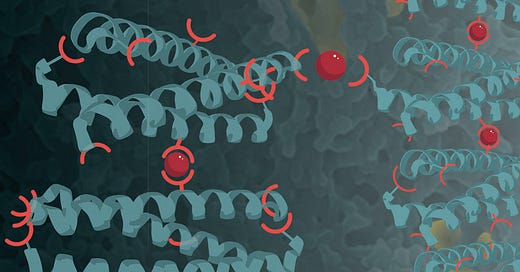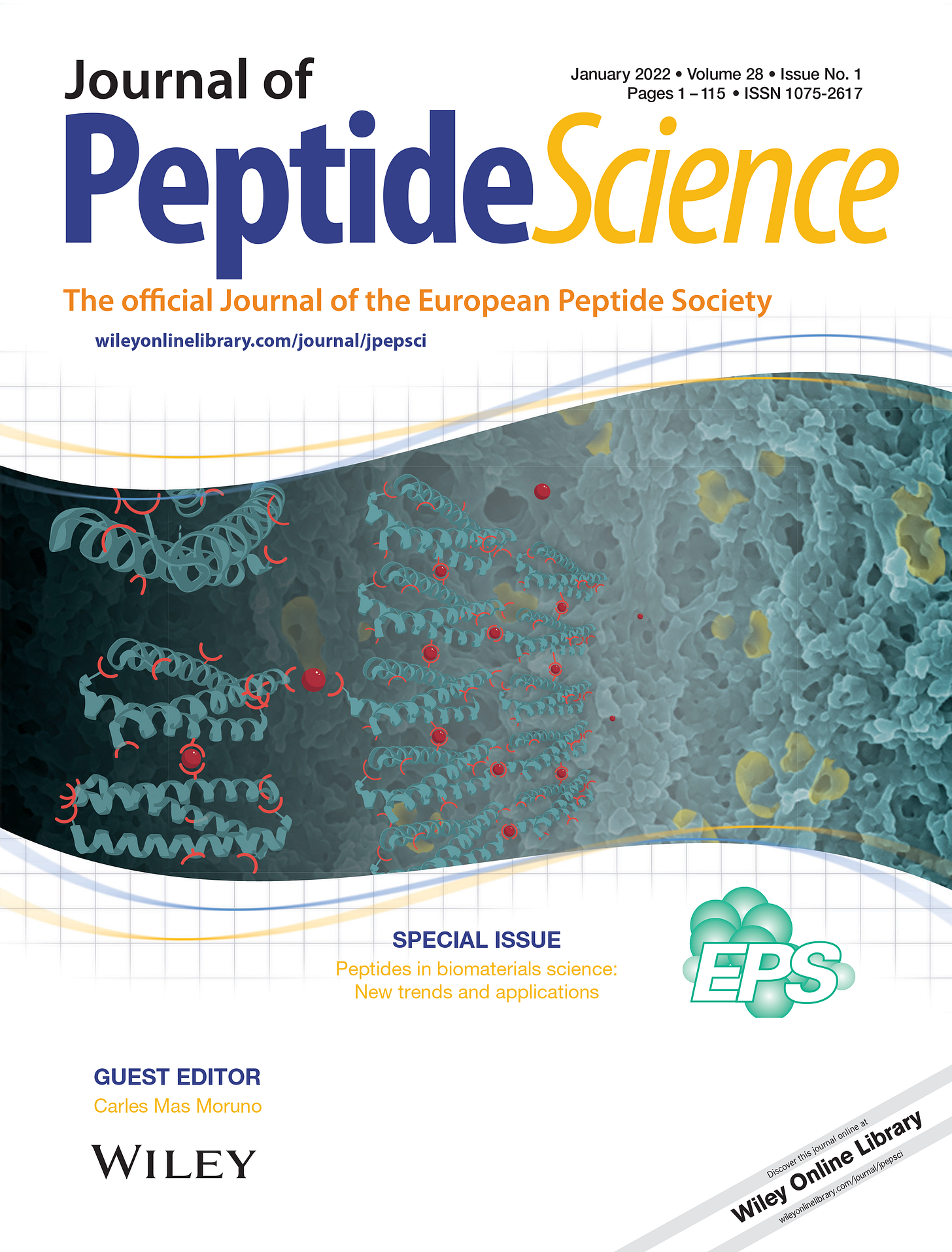This month’s exploration is about making the invisible visible—a common theme of science illustration in general. But we’re going to look at two ways of doing this, one visual and one literary. I created the cover art below to illustrate encapsulation of growing cells by self-assembling peptides from the molecular (left) to the microscopic (right) scales. Then I wrote the short braided essay that follows to describe the purpose of encapsulation by mirroring the molecular/microscopic scale with the macro scale (three years of my life). A similar version originally appeared on my illustration website in February of 2022, so apologies (and thank you) to anyone who has already read it. Inspiration for using this literary device came from Jenny Offill’s novel The Department of Speculation and Hope Jahren’s memoir Lab Girl. Both of them do it much better. But I encourage/challenge anyone trying to communicate science to give it a shot too. Maybe you could be a future guest contributor to this newsletter.
Encapsulation: A Love Letter to the Purdue Chemistry Department
I went to graduate school more or less because I wanted to be Jean Chmielewski. So when she asked me recently if I could create cover art for a themed issue of The Journal of Peptide Science, of course, I immediately agreed.
She and her graduate student Michael Jorgensen were publishing a paper in that issue on reversible encapsulation of cells in a 3D matrix that mimics their native environment—the extracellular matrix. Taking cells out of their native environment leaves them a bit lost, but Chmielewski and Jorgensen had engineered a support system for them.
I was a year and a half into my chemistry major at Purdue, a pre-med by default since I had no clue what chemists actually did, when a classmate told me that undergraduate research experience would look good on my medical school application. I asked an assistant professor named Bruce Morimoto if I could join his lab, and even though I naively told him my motivation for it, he welcomed me anyway.
Chmielewski and Jorgensen devised a support system built from peptides—short chains of amino acids which, if much longer, we would call proteins. They designed these peptides such that they would assemble themselves into groups of three, each trio gently twisting together to form something like a short length of rope. Because the peptides themselves are helical in shape, these assemblies are known as coiled coils. They also equipped each peptide with molecular arms whose hands could reach out and grab onto metal ions (red balls in the image above). Each metal ion can be held by two different hands at the same time, enabling coiled coils to join hands and self-assemble into growing 3D structures. When cells are present, these structures assemble themselves around the cells (yellow blobs in the image above) like molecular scaffolding.
In the Morimoto Lab, I was delivered into the capable hands of a warm and knowledgeable graduate student who taught me how to clone a gene and sequence DNA, decoding it old-school style from spots on a sheet of photographic film the size of a Denny’s menu. She invited me to her home and cooked Indian food for me—the first and still the best I’ve ever had. But about 6 months in, Morimoto left academia for biotech.
At any moment, the peptidic 3D support system can be disassembled by adding a molecule called a chelator that sponges up the bridging metal ions. Removing the metal disperses the coiled coils that had previously supported the cells, leaving them to fend for themselves again.
I met Professor Chmielewski at a summer BBQ where in between volleyball games she asked me if I wanted to join her lab. When I overheard her husband, Professor Mark Lipton, declare that the volleyball he’d lobbed over the net was out of bounds by only angstroms, I knew I’d found my home in the 35,000-student university. Chmielewski showed me around her lab and cleared an available desk that had accumulated books, papers, and random lab equipment, musing aloud to herself, “Nature hates a vacuum.”
Adding metal back to the system causes coiled coils to immediately re-assemble around the momentarily floundering cells, once again mimicking the supportiveness of the extracellular matrix like a surrogate family.
I often can’t remember why I walked into a room, but the sequence of the first peptide I ever synthesized is inexplicably lodged in my brain. Its 1-letter amino acid code was HCKFWW. It was designed to prevent the two halves of HIV-1 Integrase from coming together to insert the virus’s genetic code into human host DNA. The graduate student who trained me betrayed not a hint of annoyance when I repeatedly sought him out on his cigarette breaks to tell him an experiment I’d done hadn’t worked.
The nature of the 3D matrix formed by the cross-linked coiled coils makes it highly conducive to growth. The cells can expand in all directions, and the matrix harbors cavities that allow them room to grow.
I eventually became more independent and set up a way to measure HIV-1 Integrase’s activity. After repeated failures, I finally got it to work. Seeing the result while alone in the darkroom with only the photographic film developer whirring its congratulations, you’d have thought I’d discovered penicillin. Later, without a whiff of patronizing, Chmielewski heartily joined me in celebrating this meager accomplishment.
With this kind of steady support for the cells, one could imagine the possibility of growing organoids—miniature organs that grow in 3 dimensions and resemble a real organ—for research purposes.
One graduate student in the lab and his friend from the Fuchs lab down the hall invited me to join them for their weekly Taco Tuesday lunches at Taco Bell. They giggled on the way back to lab one Tuesday after we’d run into one of my friends there, still wearing her clothes from the previous night out, make-up smeared, desperately seeking relief from her hangover in a 7-layer burrito. (Which is not to suggest that I was any stranger to a hangover myself.)
Another graduate student in the lab, now an environmental health scientist at the CDC, presented me with an award for undergraduate research at a small ceremony, and then hours later, returned with me to the same spot to re-enact the scene for my roommate and best friend since age 15. She was in class during the ceremony but absolutely insisted on getting a photograph. (This feature of her hasn’t changed in the decades of friendship since.) I would not have remembered that moment had my labmate not staged this reenactment. And I certainly wouldn’t have known how important it apparently was for me at the time, if not for the photographic evidence that I had actually put on a dress.
The real beauty of the 3D coiled-coil assembly is its reversibility. If one used it to grow an organoid, for example, the metal ions could be removed when the fledgling mini-organ was ready to carry out its intended function, and the scaffolding would fall away.
On the day of my graduation, the lab held a small celebration, including a tradition typically carried out by newly minted PhDs after their thesis defense—popping a champagne bottle and trying to break the record for distance traveled by the cork down the hallway outside the lab. A senior graduate student in the lab gifted me a leather-bound composition book for taking seminar notes. On the inside back cover is a lovely inscription, at the end of which he quips, “I hope this small token of my gratitude will serve you well in your scientific journeys as a storehouse of knowledge and inspiration. Now get back to work.” It is now filled with seminar notes dating from 1999-2005 alongside drawings of speakers and assorted audience members. A graduate student from another lab on the same floor who is now a scientist at Eli Lilly gave me a copy of All the King’s Men by Robert Penn Warren. On the inside cover, she congratulated me for going to MIT for graduate school, and told me not to forget about all of them at Purdue. I didn’t.
I also didn’t become Jean Chmielewski. She is one of a kind. But when I think back to what seemed most appealing to me about her job, one single image comes to mind. It is of her sitting in her quiet office, illuminated only by natural light from the window. She is surrounded by stacks of journals and she’s reading one of them, sipping tea with her Teva-sandaled feet propped up on a nearby chair. (Clearly I was shielded from the administrative duties and endless cycle of grant proposal writing.) I realize now that what I really wanted all along was the opportunity to read about science and try to come up with creative ideas, as she did, and continues to do. So I guess I did get my wish, and now, every so often, I get to do that with my mentor.
Jorgensen, MD and Chmielewski, J, Reversible crosslinked assembly of a trimeric coiled-coil peptide into a three-dimensional matrix for cell encapsulation and release. J. J. Pept. Sci. 2022, 28(1)




